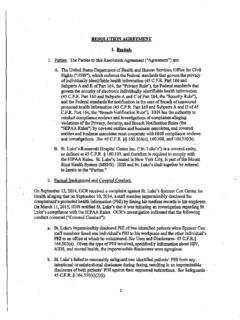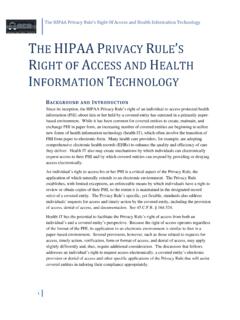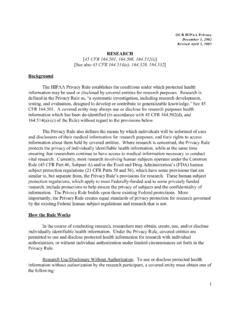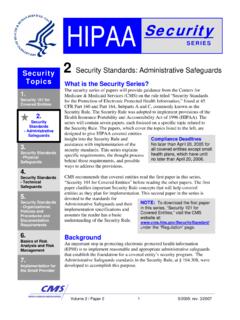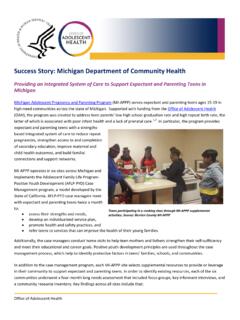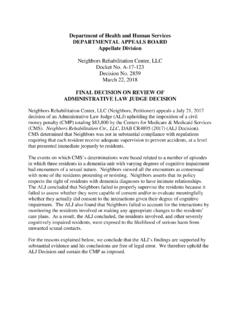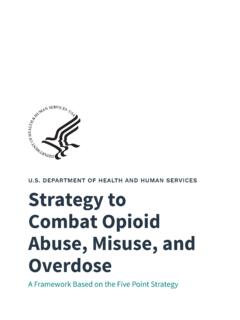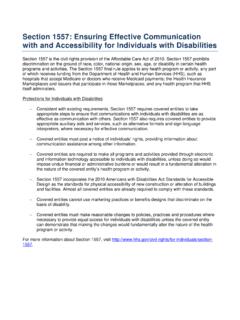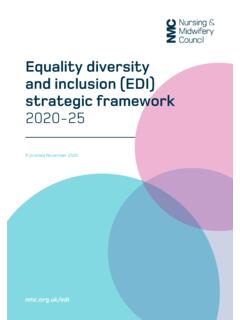Transcription of National Strategic Plan 2021-2025 - HHS.gov
1 Sexually Transmitted InfectionsNational Strategic Planfor the United States | 2021 2025iSTI National Strategic plan : 2021 2025 The United States will be a place where sexually transmitted infections are prevented and where every person has high-quality STI prevention, care, and treatment while living free from stigma and vision includes all people, regardless of age, sex, gender identity, sexual orientation, race, ethnicity, religion, disability, geographic location, or socioeconomic National Strategic plan : 2021 2025iiAcknowledgments: The Sexually Transmitted Infections National Strategic plan (STI plan ) was developed through a robust process that included gathering feedback from stakeholders across health care and related fields. Partners throughout the federal government, as well as hundreds of nonfederal stakeholders, including state, tribal, territorial, and local governments, researchers, health plans and providers, community groups, and National and local organizations that work in STI and related fields, have helped shape the goals, objectives, and strategies in this plan .
2 The Office of the Assistant Secretary for Health (OASH) and its Office of Infectious Disease and HIV/AIDS Policy (OIDP) of the Department of Health and Human Services (HHS) sincerely thank all those who contributed to making this STI plan a reality, especially staff from the Centers for Disease Control and Prevention (CDC) Division of STD Prevention who provided technical and personnel Language used in the STI plan : The STI plan places value on the lived experiences and choices of all people, regardless of age, sex, gender identity, sexual orientation, race, ethnicity, religion, disability, geographic location, or socioeconomic circumstance. To reflect this vision, a concerted effort was made to use inclusive and person-first language throughout the STI plan . Evidence-based, contemporary terminology is also used to convey respect and empowerment and to reduce stigma faced by communities and populations disproportionately impacted by these infections. Despite these efforts, specific terminology or language may be unintentionally offensive or stigmatizing to some individuals or populations.
3 Language is subjective, and the meaning and use of language changes over time. This approach is intended to help the STI plan s users to identify these societal shifts in preferred terminology and to communicate in a manner that reflects its vision for a collective, inclusive, and respectful National information regarding the STI plan and associated activities may be accessed at Suggested citation: Department of Health and Human Services. 2020. Sexually Transmitted Infections National Strategic plan for the United States: 2021 2025. Washington, National Strategic plan : 2021 2025iiiTABLE OF CONTENTSE xecutive Summary ..1I. Introduction ..4A. The Need for a STI National Strategic plan ..4B. The STI Epidemic: Challenges and Opportunities ..6C. Scope, Approach, and Development of the STI National Strategic plan ..11II. Overview of Each STI ..14A. Chlamydia ..15B. Gonorrhea ..17C. Syphilis ..19D. HPV and HPV Vaccination ..23 III. STI National Strategic plan ..25A. Vision.
4 25B. Goals ..25C. Objectives and Strategies ..26D. Priority Populations and Geographic Areas ..38E. Indicators ..43IV. Implementation and Accountability ..49A. Federal Partners ..49B. Nonfederal Partners ..49 Appendix A: Process/Methodology for Developing and Adopting the STI plan ..50 Appendix B: Indicators and Targets ..55 Appendix C: Federal Steering Committee, Subcommittees, and Staff ..58 Appendix D: Acronyms ..63 Appendix E: References ..65 STI National Strategic plan : 2021 2025ivTables, Figures, and BoxesTablesTable 1. Definitions Included in the STI plan ..26 Table 2. Priority Populations and Summary National -Level Data, Calendar Year 2018 ..39 Table 3. STI plan Core Indicators ..44 Table 4. STI plan Disparities Indicators ..47 Table Composition of Federal Steering Committee ..50 Table STI plan Core Indicators ..55 Table STI plan Disparities Indicators ..56 FiguresFigure 1. Chlamydia Rates per 100,000 of reported cases by sex, United States, 2009 2018 ..16 Figure 2.
5 Gonorrhea Rates per 100,000 of reported cases by sex, United States, 2009 2018 ..18 Figure 3. P&S Syphilis Rates per 100,000 of reported cases by sex, United States, 2009 2018 ..20 Figure 4. Congenital Syphilis Reported rates by year of birth and reported rates of P&S syphilis .. among females aged 15 44, United States, 2009 2018 ..21 Figure 5. Disparities in reported rates of STIs by race/ethnicity, 2018 ..40 Figure 6. Rates of reported cases by state, per 100,000 population, 2018 ..41 Figure 7. Percentage of adolescents who have received at least one dose of the HPV vaccine, 2018 ..42 Figure Respondent type for all public commenters with available affiliation ..52 BoxesBox 1. Ending the HIV Epidemic: A plan for America ..13 Box 2. STI Surveillance and Fact Sheets ..14 Box 3. Chlamydia Snapshot ..15 Box 4. Gonorrhea Snapshot ..17 Box 5. Syphilis Snapshot ..19 Box 6. HPV and HPV Vaccination Snapshot ..23 STI National Strategic plan : 2021 2025 Executive Summary | 1 EXECUTIVE SUMMARYOver the past decade, the United States has witnessed alarming increases in rates of sexually transmitted infections (STIs) including syphilis, chlamydia, and gonorrhea, amounting to a public health crisis.
6 From 2014 to 2018, the rates of reported cases of primary and secondary syphilis, congenital syphilis, gonorrhea, and chlamydia rose 71%, 185%, 63%, and 19%, respectively. Human papillomavirus (HPV), the most common STI, accounts for 14 million new infections each year. The consequences of the STI epidemic are enormous. When left untreated, STIs can lead to long-term, irreversible health outcomes such as chronic pelvic pain, infertility, adverse pregnancy outcomes, neonatal death, and congenital abnormalities, and can facilitate HIV acquisition. HPV can cause numerous forms of cancer, although most HPV types associated with cancer are preventable through vaccination. HPV vaccination rates are lower than for other routinely recommended childhood and adolescent vaccinations in the United States despite evidence that the vaccine has a substantial impact on reducing HPV infections, HPV-associated pre-cancers, cancers, and genital warts. Many Americans largely underestimate the risk of STIs and for myriad reasons may not proactively seek care.
7 In addition, racial and ethnic disparities contribute to an unequal burden of STIs in the United States. As recognized by several National reports and authorities, efforts to date to address STIs have been fragmented and insufficient. Despite actions to reverse the trend, resources are often strained in many state and local public health settings. In addition, STIs cost Americans billions of dollars each year in direct medical expenses. Combined, the health and economic toll can affect the quality of life and prosperity of millions of people. Coordinated, innovative approaches and sustained efforts are needed to reverse this increasing trajectory and to curtail the ever-growing burden of STIs. This inaugural STI National Strategic plan (STI plan ) sets forth a vision for the nation with goals, objectives, and strategies to meaningfully prevent and control STIs in the United States. It is intended to serve as a roadmap for federal and nonfederal stakeholders at all levels to reverse the upward trends in STI rates.
8 The STI plan focuses on four of the STIs with the highest morbidity rates, the most persistent and pervasive STI inequalities according to National data, and the greatest impact on the health of the nation: chlamydia, gonorrhea, syphilis, and HPV. HIV, another significant STI, is the focus of a separate HIV National Strategic plan . Hepatitis B and hepatitis C, which can also be transmitted sexually, are the focus of a separate Viral Hepatitis National Strategic plan . The STI plan also includes indicators to measure progress and quantitative targets for each indicator. The components of the STI plan are contained and discussed in Section III. The STI plan establishes the following vision: The United States will be a place where sexually transmitted infections are prevented and where every person has high-quality STI prevention, care, and treatment while living free from stigma and vision includes all people, regardless of age, sex, gender identity, sexual orientation, race, ethnicity, religion, disability, geographic location, or socioeconomic National Strategic plan : 2021 2025 Executive Summary | 2 Goal 1: Prevent New Increase awareness of STIs and sexual Expand implementation of quality, comprehensive STI primary prevention Increase completion rates of routinely recommended HPV Increase the capacity of public health, health care delivery systems, and the health workforce to prevent STIs Goal 2.
9 Improve the Health of People by Reducing Adverse Outcomes of Expand high-quality affordable STI secondary prevention, including screening, care, and treatment, in communities and populations most impacted by Work to effectively identify, diagnose, and provide holistic care and treatment for people with STIs by increasing the capacity of public health, health care delivery systems, and the health workforce Goal 3: Accelerate Progress in STI Research, Technology, and Innovation Support research and investments to develop STI vaccines and bring them to Support the development and uptake of STI multipurpose prevention technologies, antimicrobial prophylaxis regimens, and other preventive products and Support the development and uptake of innovative STI diagnostic technologies, therapeutic agents, and other interventions for the identification and treatment of STIs, including new and emerging disease Identify, evaluate, and scale up best practices in STI prevention and treatment, including through translational, implementation, and communication science research Goal 4.
10 Reduce STI-Related Health Disparities and Health Reduce stigma and discrimination associated with Expand culturally competent and linguistically appropriate STI prevention, care, and treatment services in communities disproportionately impacted by Address STI-related social determinants of health and co-occurring conditions Goal 5: Achieve Integrated, Coordinated Efforts That Address the STI Integrate programs to address the syndemic of STIs, HIV, viral hepatitis, and substance use Improve quality, accessibility, timeliness, and use of data related to STIs and social determinants of Improve mechanisms to measure, monitor, evaluate, report, and disseminate progress toward achieving National STI goalsThis vision is accompanied by five high-level goals, which frame the STI plan s more specific objectives. The order of goals and objectives does not indicate any prioritization, and many are intertwined. The five goals and associated objectives are as follows:STI National Strategic plan : 2021 2025 Executive Summary | 3 The vision, goals, objectives, and other components of the STI plan were developed and approved by a dedicated Steering Committee, composed of subject matter experts from across the federal government, with public comment from numerous and varied stakeholders.
